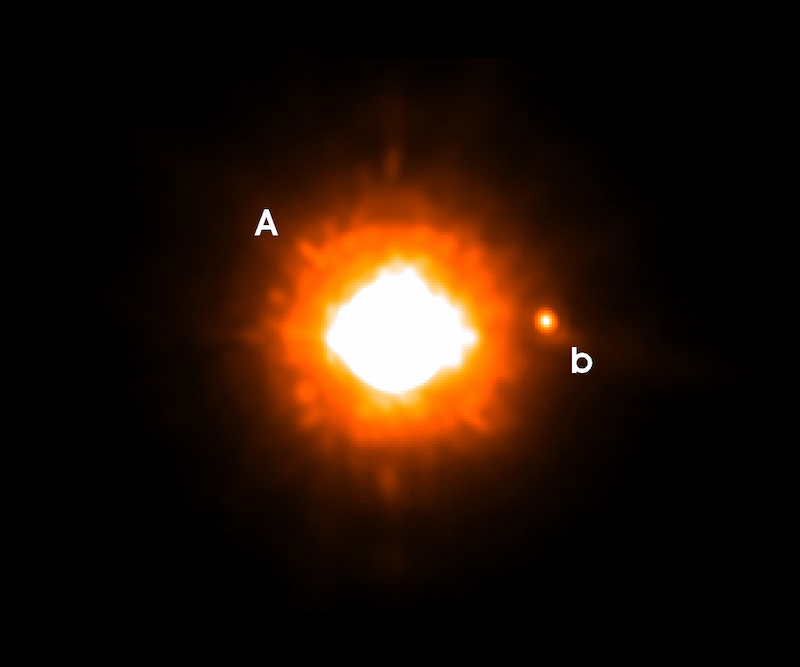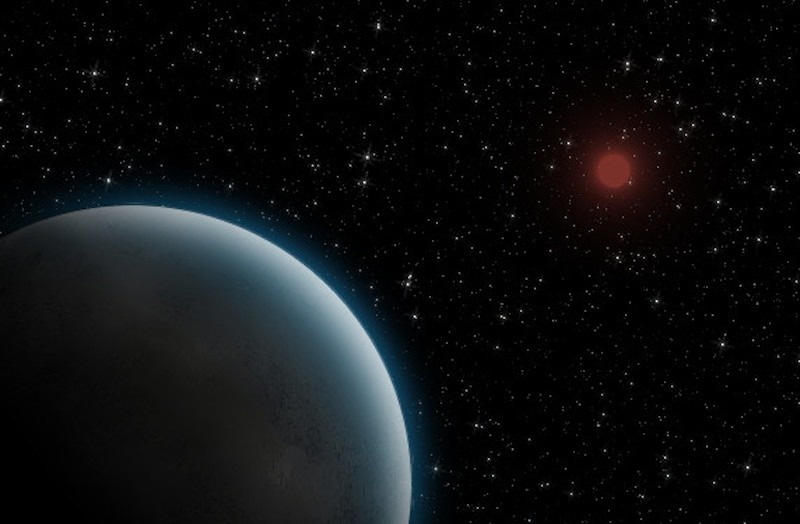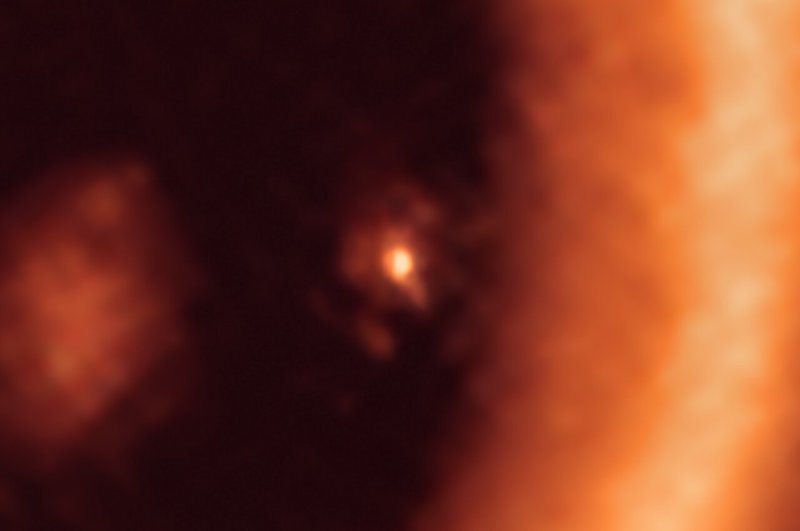
Last July, astronomers said they’d found a moon-forming disk of dust around a large exoplanet, about 400 light-years from Earth. It was the first clear evidence of a moon-forming disk – aka a circumplanetary disk – around a young giant exoplanet. On October 13, 2021, astronomers said they’d found another one. They said they believe a similar disk moves around the super-Jupiter exoplanet GQ Lupi b, located about 495 light-years away. So this super-Jupiter, too, might be forming its own moons. Wow!
Tomas Stolker at Leiden University in the Netherlands led the new study. The peer-reviewed Astronomical Journal will be publishing their findings. In the meantime, here’s a free preprint.
Is this really a moon-forming disk?
The astronomers used the NACO and MUSE instruments on the Very Large Telescope (VLT) in Chile to observe the disk more closely. They found that the disk itself, composed of dust, is much cooler than the atmosphere of GQ Lupi B. What does that mean? Basically, it indicates there is likely a central cavity or hole in the disk.
There are two possible explanations for the cavity, the researchers say. Either the dust has been swept away in that region by young, still-forming moons or by a magnetic field around GQ Lupi B.

From the paper:
The disk of GQ Lup B is cool compared to its atmosphere, as well as dust sublimation temperatures. We speculate that the disk is in a transitional stage in which the inner regions have been cleared by the formation of satellites while the remaining gas is being accreted onto the atmosphere.
The researchers made these measurements using NACO, an infrared camera, which observed infrared light coming from the dust disk. The gas may come the planet’s own disk, called a protoplanetary disk – where planets are born – surrounding the planet’s star.
Meanwhile, the MUSE spectrograph measured H-alpha radiation in the disk. The results suggest that GQ Lupi B itself is still a growing world.

Planet or brown dwarf?
There is also still some debate as to what kind of object GQ Lupi B might be. It is usually referred to as a super-Jupiter, meaning it is more massive than Jupiter. It’s exact mass is not yet known precisely, however, so sometimes it is referred to a a giant planet and sometimes as a brown dwarf. Brown dwarfs are larger than planets, but smaller than the smallest stars. They collect material like a star does when they form, but not enough to begin stellar fusion.
For reference, when the B in GQ Lupi B is written as a capital, it refers to the object as a brown dwarf. However, when written with a small b, it means planet.
GQ Lupi B, discovered in 2004, is quite far away from Earth, at about 500 light-years. It is located in the southern constellation Lupus. It is much more massive than Jupiter and orbits its star 20 times farther out than Jupiter is from our sun.

Another moon-forming disk
Last July, scientists announced the discovery of a similar moon-forming circumplanetary disk around the giant planet PDS 70c. The planet’s star, PDS 70, is also very young and is located about 400 light-years away in the constellation Centaurus.
PDS 70c is one of two known planets that orbit this star. Its dusty disk was discovered by the ALMA telescope in Chile. The disk contains enough material to form three moons the size of Earth’s moon.
Scientists expect that many more of these disks will be discovered, where moons are being born. This is based on their knowledge, so far, as to how the many moons in our own solar system formed. Just as with planets, those processes are likely common throughout our galaxy.
Future observations
The researchers are hopeful that the upcoming James Webb Space Telescope (the Webb) will be able to take a closer look at GQ Lupi B. According to Stolker:
Webb can take spectra at mid-infrared wavelengths. That is very challenging from Earth. In doing so, we could learn much more about the physical and chemical processes in the disk of GQ Lupi B that may enable the formation of moons.
While astronomers haven’t yet definitively found any exomoons, they are getting closer, and there are some tentative candidates. Exomoons themselves are difficult to detect, but moon-forming disks like those at GQ Lupi B and PDS 70c show that they should be out there. How many are just waiting to be discovered?
Bottom line: European astronomers say that there may be moons being created in a disk of dust around a giant super-Jupiter planet (or brown dwarf) 500 light-years away. It is the second possible birthplace of distant exomoons identified so far.
Source (preprint): Characterizing the protolunar disk of the accreting companion GQ Lupi B
The post Moon-forming disk around super-Jupiter exoplanet? first appeared on EarthSky.
from EarthSky https://ift.tt/2Z8KydJ

Last July, astronomers said they’d found a moon-forming disk of dust around a large exoplanet, about 400 light-years from Earth. It was the first clear evidence of a moon-forming disk – aka a circumplanetary disk – around a young giant exoplanet. On October 13, 2021, astronomers said they’d found another one. They said they believe a similar disk moves around the super-Jupiter exoplanet GQ Lupi b, located about 495 light-years away. So this super-Jupiter, too, might be forming its own moons. Wow!
Tomas Stolker at Leiden University in the Netherlands led the new study. The peer-reviewed Astronomical Journal will be publishing their findings. In the meantime, here’s a free preprint.
Is this really a moon-forming disk?
The astronomers used the NACO and MUSE instruments on the Very Large Telescope (VLT) in Chile to observe the disk more closely. They found that the disk itself, composed of dust, is much cooler than the atmosphere of GQ Lupi B. What does that mean? Basically, it indicates there is likely a central cavity or hole in the disk.
There are two possible explanations for the cavity, the researchers say. Either the dust has been swept away in that region by young, still-forming moons or by a magnetic field around GQ Lupi B.

From the paper:
The disk of GQ Lup B is cool compared to its atmosphere, as well as dust sublimation temperatures. We speculate that the disk is in a transitional stage in which the inner regions have been cleared by the formation of satellites while the remaining gas is being accreted onto the atmosphere.
The researchers made these measurements using NACO, an infrared camera, which observed infrared light coming from the dust disk. The gas may come the planet’s own disk, called a protoplanetary disk – where planets are born – surrounding the planet’s star.
Meanwhile, the MUSE spectrograph measured H-alpha radiation in the disk. The results suggest that GQ Lupi B itself is still a growing world.

Planet or brown dwarf?
There is also still some debate as to what kind of object GQ Lupi B might be. It is usually referred to as a super-Jupiter, meaning it is more massive than Jupiter. It’s exact mass is not yet known precisely, however, so sometimes it is referred to a a giant planet and sometimes as a brown dwarf. Brown dwarfs are larger than planets, but smaller than the smallest stars. They collect material like a star does when they form, but not enough to begin stellar fusion.
For reference, when the B in GQ Lupi B is written as a capital, it refers to the object as a brown dwarf. However, when written with a small b, it means planet.
GQ Lupi B, discovered in 2004, is quite far away from Earth, at about 500 light-years. It is located in the southern constellation Lupus. It is much more massive than Jupiter and orbits its star 20 times farther out than Jupiter is from our sun.

Another moon-forming disk
Last July, scientists announced the discovery of a similar moon-forming circumplanetary disk around the giant planet PDS 70c. The planet’s star, PDS 70, is also very young and is located about 400 light-years away in the constellation Centaurus.
PDS 70c is one of two known planets that orbit this star. Its dusty disk was discovered by the ALMA telescope in Chile. The disk contains enough material to form three moons the size of Earth’s moon.
Scientists expect that many more of these disks will be discovered, where moons are being born. This is based on their knowledge, so far, as to how the many moons in our own solar system formed. Just as with planets, those processes are likely common throughout our galaxy.
Future observations
The researchers are hopeful that the upcoming James Webb Space Telescope (the Webb) will be able to take a closer look at GQ Lupi B. According to Stolker:
Webb can take spectra at mid-infrared wavelengths. That is very challenging from Earth. In doing so, we could learn much more about the physical and chemical processes in the disk of GQ Lupi B that may enable the formation of moons.
While astronomers haven’t yet definitively found any exomoons, they are getting closer, and there are some tentative candidates. Exomoons themselves are difficult to detect, but moon-forming disks like those at GQ Lupi B and PDS 70c show that they should be out there. How many are just waiting to be discovered?
Bottom line: European astronomers say that there may be moons being created in a disk of dust around a giant super-Jupiter planet (or brown dwarf) 500 light-years away. It is the second possible birthplace of distant exomoons identified so far.
Source (preprint): Characterizing the protolunar disk of the accreting companion GQ Lupi B
The post Moon-forming disk around super-Jupiter exoplanet? first appeared on EarthSky.
from EarthSky https://ift.tt/2Z8KydJ

Aucun commentaire:
Enregistrer un commentaire